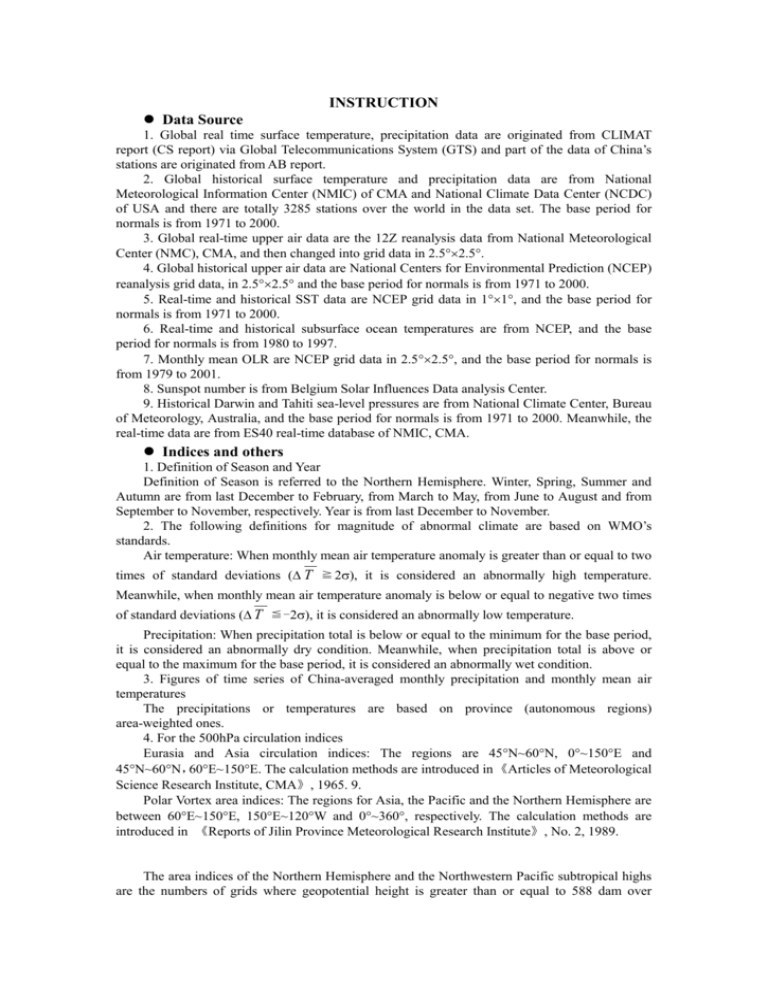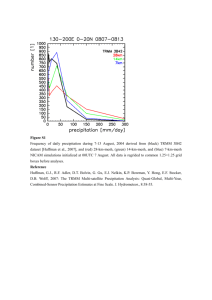Indications
advertisement

INSTRUCTION Data Source 1. Global real time surface temperature, precipitation data are originated from CLIMAT report (CS report) via Global Telecommunications System (GTS) and part of the data of China’s stations are originated from AB report. 2. Global historical surface temperature and precipitation data are from National Meteorological Information Center (NMIC) of CMA and National Climate Data Center (NCDC) of USA and there are totally 3285 stations over the world in the data set. The base period for normals is from 1971 to 2000. 3. Global real-time upper air data are the 12Z reanalysis data from National Meteorological Center (NMC), CMA, and then changed into grid data in 2.52.5. 4. Global historical upper air data are National Centers for Environmental Prediction (NCEP) reanalysis grid data, in 2.52.5 and the base period for normals is from 1971 to 2000. 5. Real-time and historical SST data are NCEP grid data in 11, and the base period for normals is from 1971 to 2000. 6. Real-time and historical subsurface ocean temperatures are from NCEP, and the base period for normals is from 1980 to 1997. 7. Monthly mean OLR are NCEP grid data in 2.52.5, and the base period for normals is from 1979 to 2001. 8. Sunspot number is from Belgium Solar Influences Data analysis Center. 9. Historical Darwin and Tahiti sea-level pressures are from National Climate Center, Bureau of Meteorology, Australia, and the base period for normals is from 1971 to 2000. Meanwhile, the real-time data are from ES40 real-time database of NMIC, CMA. Indices and others 1. Definition of Season and Year Definition of Season is referred to the Northern Hemisphere. Winter, Spring, Summer and Autumn are from last December to February, from March to May, from June to August and from September to November, respectively. Year is from last December to November. 2. The following definitions for magnitude of abnormal climate are based on WMO’s standards. Air temperature: When monthly mean air temperature anomaly is greater than or equal to two times of standard deviations ( T ≧2), it is considered an abnormally high temperature. Meanwhile, when monthly mean air temperature anomaly is below or equal to negative two times of standard deviations ( T ≦-2), it is considered an abnormally low temperature. Precipitation: When precipitation total is below or equal to the minimum for the base period, it is considered an abnormally dry condition. Meanwhile, when precipitation total is above or equal to the maximum for the base period, it is considered an abnormally wet condition. 3. Figures of time series of China-averaged monthly precipitation and monthly mean air temperatures The precipitations or temperatures are based on province (autonomous regions) area-weighted ones. 4. For the 500hPa circulation indices Eurasia and Asia circulation indices: The regions are 45N~60N, 0~150E and 45N~60N,60E~150E. The calculation methods are introduced in 《Articles of Meteorological Science Research Institute, CMA》, 1965. 9. Polar Vortex area indices: The regions for Asia, the Pacific and the Northern Hemisphere are between 60E~150E, 150E~120W and 0~360, respectively. The calculation methods are introduced in 《Reports of Jilin Province Meteorological Research Institute》, No. 2, 1989. The area indices of the Northern Hemisphere and the Northwestern Pacific subtropical highs are the numbers of grids where geopotential height is greater than or equal to 588 dam over regions between 0~360 and 110E~180, respectively. Intensity index is the accumulation of the difference between geopotential height and 587 dam for each of the above grids in a certain region. The Qinghai-Tibet Plateau index is defined as the accumulation of the difference between geopotential height and 500 dam for every grid in a certain region. There are two different indices for different regions: region A is 25N~35N,80E~100E, and region B is 30N~40N, 75E~105E. The Qinghai-Tibet Plateau index in Fig.3.12 is that for region B. India-Burma trough index is defined as the accumulation of the difference between geopotential height and 580 dam for every grid in the region of 15N~20N,80E~100E. 5. Other indices SST indices are defined as the averages of SST and SSTA for certain regions. There are several different regions, where the composite NINO region ( NINO Z) is composed of three regions: NINO 1+2, NINO 3 and NINO 4, and the NINO Z index is area-weighted average of the three different indices. Details refer to 《Acta Meteorological Sinica》, 2000,Vol. 58, No. 1: 102~109. Warm Pool Intensity Index is defined as the standardization of the series of the accumulation for a certain region of the difference between SST and 28℃ for a grid where SST is greater than 28℃. There are two different regions: the Western Pacific warm pool region is 30°N~30°S, 120°E~180° and the Indian Ocean warm pool region is composed of 30°N~8°S, 41°E~98°E and 8°S~30°S,41°E~120°E. Southern Oscillation Index (SOI) is defined as the standardization of the series of the difference between standardized Tahiti and Darwin sea-level pressures. For the SLP in Table 4.1, the top values are the difference between actual values of SLP and 1000hPa, while the bottom values are SLP anomalies. Convection Oscillation Index (COI) is defined as the standardization of the series of the difference between the standardized OLR over two regions of the central and eastern equatorial Pacific OLR and the western equatorial Pacific OLR. Details refer to 《Quarterly Journal of Applied Meteorology》, 1998, Vol. 9, No. 2: 169~177. Wind Index is defined as the standardized area-mean zonal (or meridional) wind for a certain region. The definitions of Meiyu start and end dates refer to 《Acta Meteorological Sinica》, 1965, Vol. 35, No. 4: 509~518. The region for South China Sea monsoon is defined as 10°N ~20°N, 110°E ~120°E. 6. Graphics Contour values in Figs for 100hPa geopotential height are the differences between the actual values and 1600dam. In Figures 3.9~3.12, solid lines with the mark “o” represent actual values of the month, while dashed lines represent normals. Figure 4.3, Figure 4.12, Figure 4.13 and Figure 4.17 are for the average in a belt between 5N~5S. In Figure 4.8 and Figure 4.13, column represents actual value of the month, while line represents five-month running mean. 7. ENSO prediction models The analogue prediction model refers to 《Acta Meteorological Sinica》, 2001,No. 1. The maximum entropy singular spectrum analysis model refers to 《Advances in Atmospheric Sciences 》, 2001, No. 5. The principal component canonical correlation analysis model, the optimum filtering assembly model, the assessment ensemble scheme model and the recursion ensemble scheme model refer to 《Studies on ENSO Monitoring and Prediction》. 8. Distribution of the SST monitoring regions is shown in the map in page 2.




![[#EXASOL-1429] Possible error when inserting data into large tables](http://s3.studylib.net/store/data/005854961_1-9d34d5b0b79b862c601023238967ddff-300x300.png)
